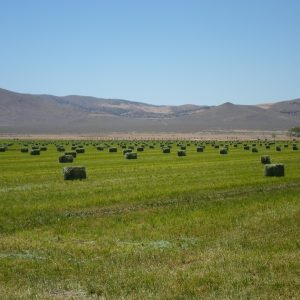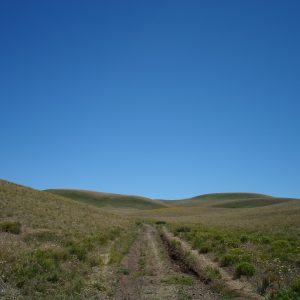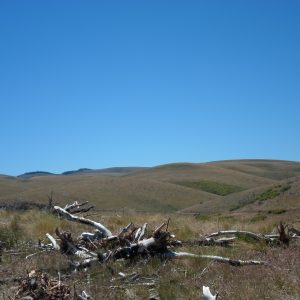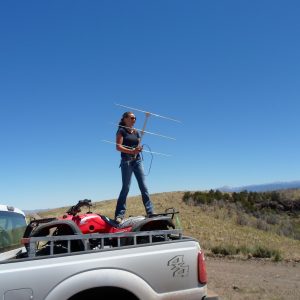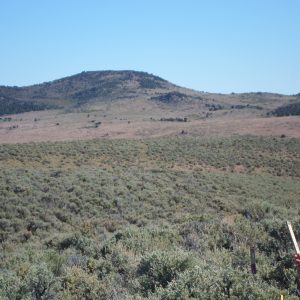I finished up school in Illinois in May. Shortly there after I moved to Carson City Nevada. The desert is certainly very different from the lush forest of Southern Illinois or the Oak Savannas of Chicagoland. While I certainly miss the big trees of my home state, I am learning to appreciate the natural beauties of Nevada. So far I have seen some cool looking Eriogonum and Poppies. My crew has been doing a lot of post-fire monitoring which I like because it really improves my plant identification skills and gives me more experiencing mapping and using GIS. Everyone I work with is very friendly and interesting. My mentor has also been very helpful and is extremely knowledge about our local environment. I am excited and curious about what the future holds for the next five months!
“Oh Yes, Wyoming!”
- Destination: Rock Springs, WY
- Mission: Seeds of Success
- Mood: Enthusiastic
Standing beneath the midnight stars at a rest stop in the Bonneville Salt Flats after hastily constructing a bed accross the passenger seat of my car I had more time to consider what may lie beyond the horizon, both literally and figuratively…mostly figuratively.
Yes, there would be plenty of sagebrush in southwestern Wyoming. Everyone knows that, right? But what else would be waiting for me in this new, dry land–this wild arena of mystery and vastness that would become my home for the next five months?
I envisioned an endless swath of flat desert, dotted with solitary hills and lonely roads disappearing into the unknown. Rock Springs itself sounded like the kind of rough and tumble town you’d stop in for the evening to tie up your horse and hang your hat after a long day’s ride through the great, American steppe.
Upon arrival it became clear that whatever changes this adventure held in store for me would be welcomed and explored with curiosity and patience. Indeed, Rock Springs bears little resemblance, physically or in cultural atmosphere, to Berkeley, CA, from where I began this journey, but I foresee the myriad differences serving to foster in me an attitude of excitement and acceptance, a proclivity toward adaptation.
Rock Springs is beautiful. I am happy to be out of my comfort zone and in a new land full of opportunity. Opportunity to explore the West, to meet new people, to see new things and to see things anew. My time with the BLM is still in its infancy; I’ve been here only a couple weeks and have yet to really delve into my internship. But I’ve definitley enjoyed the days I’ve spent in the field so far.
Lots of space, lots of wildlife, lots of wind, lots of trucks, lots of outdoor recreation, lots of friendly folk. “Oh Yes, Wyoming!”
-Chris McCoy
Botany Joke of the Month: What’s a sheep’s favorite flower?
Answer: Phlox!
A long time gone
It’s been a while since my last post, but there has been no shortage of exciting work out in northwestern California. Instead of try to cover everything I’ll focus on a recent adventure of note. Last week I hiked the Lost Coast Trail with the fisheries biologist, his primary focus installing annual temperature gauges in creeks running down from their headwaters in the coastal King Range to the Pacific, and my task, map and treat invasive weed infestations. Mostly this resulted in as much manual removal of iceplant, foxglove, and a few others from the steep sandy cliffs along the coast. It was an amazing opportunity to monitor an area otherwise inaccessible except by foot. Though only a 24 mile hike split into four days, we were lugging heavy loads and hiking mostly on soft sand while dealing with impassable segments during high tides, and coping with the frustration of not being able to reach some of the crafty invasives thriving on inaccessible sandstone faces.
It was nice to have an opportunity to get to know a section of BLM land that few members of the office regularly monitor, and my hiking partner and I enjoyed the relaxed nature of spending long days in the field without the pressure to drive back to the office a few hours away each evening. The scenery was unmatched with steep mountains rising directly from the ocean to upwards of 4000 feet in less than three miles. This was a trip I will not soon forget, with memorable sunsets and plenty of valuable exploration. The only proper way to conduct landscape management is not see the ecology firsthand.
Out in the Field
With the sun scorching the plants, seeds are ready for collecting!
I haven’t had much time in the lab lately because we are constantly driving out to our field sites to collect seeds from our target plants. At times we get disappointed when we arrive at our site because the seeds are almost ready, meaning we have to leave the site empty-handed, but we always plan to go back to the site a week or so later hoping the seeds will be ready by then. Usually the seeds are and we can collect on our second trip out. Although on our second trip out we may run into other problems, such as no more seeds being left on the plant because of high winds or grazing from animals.
For example, at out McCain Valley site, we had two Lupinus species we were very eager to collect. When we went out one week hoping the pods would be ready to collect, they weren’t ready. So we estimated they’d be ready in about two weeks. Well, when the beginning of the second week came around, we decided to head out and check. When we arrived we were sadly disappointed, apparently Lupine’s are cream of the crop! Who would have thought? 😀 Of course the tasty pods had been munched on and we were unable to collect the seeds to make a complete seed lot. Aside from a few seeds that were still left in some pods, we decided to leave those for nature and marked Lupinus concinnus and Lupinus excubitus off our list. Laurie will keep an eye out for these two species next year when she monitors McCain Valley.
The Great Grouse Chase
- Some of our sage grouse love agricultural fields, lots of juicy bugs and water
- Road through sage grouse study area
- A good view of some classic sage grouse habitat
- Searching for an elusive radio signal
- Some more sage grouse habitat
- Doing a vegetation plot
The past couple weeks have been dominated by learning the art of radio telemetry and tracking sage grouse through the hills. I have been helping a graduate student with her research on their movements and habitat use patterns. The grouse is not a federally listed endangered species here and a lot of effort is going into better understanding and hopefully building their populations so it stays that way.
They are funny birds; I love to see their snaky little heads and necks bobbing just above the level of the sage brush before you startle them. Tracking them with the telemetry equipment is like a treasure hunt or a child’s game of hot and cold. As the beeping signal gets stronger and louder you’re are ‘getting warmer’. When you do finally find the bird and it flushes, it is ultra rewarding. They fly up in a great rush and fuss of feathers, often leaving a small rain of droppings as a parting gift. The telemetry can be very tricky as the signal bounces of hills and funnels through drainages. Often we thought, “Oh, the bird is just over this ridge!” only to find it was hanging out (or loafing in grouse-speak) two valleys over.
Another part of the research is doing vegetation transects where we find birds, estimating plant cover mostly. This is less exciting but it’s still great to be outdoors and in the field. I often find myself wishing I was in a kid’s public television show called Cyberchase. In this show (designed to teach math and problem solving), these kids go into a Cyberland that is essentially a computer. When they are faced challenge to solve, they can just use these little remotes to project say a perfect square on the landscape or equally divide a piece of wood or make all the plants of a certain species glow green. Doesn’t this sound like it would be handy for field work? No dragging around tapes or pvc pipe Daubenmire squares. Alas, my fieldwork is in Utah, not Cyberland.
Other than sage grouse, this past week I got to take a look at some wild horses removed from a piece of private land. Our office wild horse guy gave some startling stats about the costs of managing the wild horses herds in Utah. To keep the horses and the rangelands healthy, thousands of horses have to be removed yearly. Used to be a large proportion were adopted, but with the economy down adoptions are way down as well and the BLM has to pick up the tab for maintaining the left over horses. It’s a puzzle. One interesting solution is a pairing with a prison here where the inmates help with the care and breaking of the horses. I had heard of horse therapy for troubled youth and people with disabilities but prisoners was a new and interesting idea.
That’s bout it round here, should be tracking more grouse next week. Maybe will pin down the one elusive female with a brood whose been hiding out in a remote wash…
Getting Started in Lockeford, CA
Greetings from the Chicago Botanic Garden!
Although I’m interning at the California Plant Materials Center in Lockeford, California (CAMPC), I have spent the past week at the Garden for a training conference along with many of the other CLM interns. The conference has been intense but enjoyable, with sessions on Western flora, monitoring techniques, and training for the Seeds of Success (SOS) program. The week has been an opportunity to not only learn and practice some of the skills necessary for our jobs but also to meet and network with the other interns and ask questions of the instructors.
The conference has helped to emphasize the importance of the work that my fellow intern and I will be doing over the next few months. We will be collecting seeds for the SOS program and have already done two scouting trips to Red Hills in Tuolumne County as well as Walker Ridge in Lake County. We make up part of a large team of collectors spread out mostly across the Western United States tasked with collecting native plant material than is stored and can ultimately be made available and used for restoration or rehabilitation purposes. Seed collection is only the first step in this process, and I am lucky to be stationed at the CAMPC, which is involved in developing and growing native plant populations on their facility. This work represents some of the other steps that must be taken before seeds collected through SOS can actually be utilized. I’ve only been working for a few weeks, so I’m looking forward to learning more about the real-life complexities of this process and more about the work that goes on at the Plant Materials Center.
My Third Month in Southern California
Hi all!
Just finished up my third month here in the Bakersfield Field Office with the Bureau of Land Management, and boy is it getting hot!! Silly humans, making cities in the desert.. anyway, this last month has been a little trying, as we are having to be patient and wait for the few accessions of seeds we’ve targeted become ripe. It has been an especially dry year here and so my co-worker and I have only gotten about 15 collections in these last few months. Better than nothing for sure, but in a good year, we would have come away with a lot more. Oh well, ya do whatcha can. Most of what we’ve been doing though, has been Seeds of Success work. We also out out on RHA’s (rangeland health assessments) and travel to sites for maintenance tasks like fence repair and invasive species removal, but a lot of our our summer has been traveling between sites with our fingers crossed that we’ve come at just the perfect time to collecte seed. Recently, we were back up in the San Joaquin River Gorge and managed to collect four different species on our overnight trip – Brodiaea elegans (Harvest Brodiaea), Castilleja attenuata (attenuate Indian paintbrush), Collinsia heterophylla (purple Chinese houses) and Phacelia egena (rock Phacelia or Kaweah River Phacelia).
I also went to Lamont Meadows recently, on the Back Country Byway, where I saw my very first Western diamondback rattlesnake. I also saw some great, showy plants which have been lacking down in the dry, sunny valley. I saw some western columbine (Aquilegia formosa), a sweet penstemon (I believe it’s Penstemon grinnellii, not sure of the ssp.), the lovely indian paintbrush (Castilleja sp.) and a beautiful native thistle (Cirsium occidentale, did not key to ssp.). We were at 5600 feet, which availed itself to flowers still in bloom for me to ogle over!
I’ve yet to experience all the reaches of our field office, as I haven’t been up into the Sierra foothills or over to the coast yet, but our mentor already had a lot on his plate before we came along, so it’s understandable that he doesn’t have all the time in the world to show us around our area. There’s a small chance though that I’ll get over the coast, to Point Sal and up to Case Mountain in the Sierras before I leave, so I’ll keep my fingers crossed! The weather has been showing its muscle as it was in the low 100’s for three or four days straight, recently. I am really scared of this hot weather! lol I just fill up my camel back and bring some extra bottles of water and hope for the best! We are in the middle of a high 80’s stint right now though, so I am just stoked about that! I love seeing how my temperature baseline changes depending on where I live.. a couple months ago it was only like 75 out and I had goosebumps! lol
I hope everyone is having a great summer and is staying cool and hydrated! Best wishes to everyone for as much education and adventure as you can handle! 🙂
Until next time,
Rachel Snyder
BLM, Bakersfield, CA
– Greetings from the Mojave –
I saw a bobcat for the first time in the Mojave two days ago while doing field work . I wrote this a short time afterward.
THE BOBCAT – by Aaron Sedgwick
Rising from the sand slinks the carnivorous grendel,
Jewel of the Mojave. Diamond eyes and cat-sized.
Shadows run from her gaze, Silent steps on the salt flats.
Maneuvering the wreckage of a thousand burned out buggies,
Glass bottle shards, Shotgun shells.
Fixed on the resting jackrabbit,
Tunnel vision stalking, buzzards hawking for the kill to come.
She… p o u n c e s
Bounding and bouncing jackrabbit shatters the calm.
Dust devil cage binds the pair together,
Freeing them when the howling stops.
Smiling and lapping the last drop from her chin,
She returns to silence.
————————–
I made three seed collections over the last two days! They were all from previously scouted populations that I had scouted for way back in April. It’s exciting to successfully utilize previously scouted information from the same field season that I’ve personally collected.
One difficulty with the abnormally dry conditions in the Mojave has been that population data and vouchers from previous wetter years do not reflect the current conditions and distribution of species in the field. Frequently, many of the populations that we are documenting are not even flowering , but the population data may be useful either next year or later in the summer when monsoon season begins. This means that every seed collection is sensational and precious this year. I’ve often thought that the plants that are producing seed this year could have particular sets of traits that are favored during dry years, making their genetics valuable for restoration. They could possibly be better adapted to the climate change projections for southern California, which predict a drier and hotter Mojave.
Montana Native Plant Society
This last weekend I had the opportunity to go to the Montana Native Plant Society Annual Meeting in Missoula, MT. The drive was long, but it was worth it. I was able to meet a lot of great botanists, who did all that they could to help me learn some new plants (and since I am originally from Iowa, the number of plants that I didn’t know out numbered the ones I did). I was even able to meet the author of the newly published Manual of Montana Flora, which will be our new go-to field guide. On Saturday, I went on a fieldtrip to the Garnet Ghost Town, which involved botany stops along the way to look at what plants were present, and then a tour of the ghost town. Overall, the group saw 131 different plant species within just a few yards of the road. My favorite plant that we saw had to be the bear grass (although the lady slipper is a close second).
Work and Workshop! Krista Butler- Ridgecrest BLM
As a part of the CLM Internship program, there is a week long workshop we can attend as a part of our training. This year, we were at the Chicago Botanic Garden and it was spectacular! The workshop kept us busy all day, so many informative sessions covering a wide range of important topics to our jobs. We had classes focusing on plant identification, conservation genetics, monitoring techniques, wildlife conservation, the different federal agencies, and more! It was a beautiful setting, in eco-friendly buildings on a lush campus. It was very rewarding to meet Krissa and Marian, the people running our program, and a good number of the other interns from all over the country.
I have been able to finally begin some seed collecting in the Ridgecrest Field Office area. It’s been a very dry year, so the only plants producing seed in large enough quantities to collect enough seeds for the Seeds of Success program, are some of the larger annual shrubs. I’ve been working on collections for Salazaria mexicana (paper bag bush), Cleome isomeris (bladderpod), and will soon be starting on Larrea tridentata (creosote bush). It’s been interesting to see first hand how what seem like minor differences in climate regimes can make huge differences in the reproductive capabilities of a species for a season. One collection I made of bladderpods is significantly more impressive and valuable than the first collection I made, largely due to their location differences.
I recently had the opportunity to go into the field with my mentor, a wildlife biologist, to assist in the surveying of abandoned mines for bat and other wildlife habitat. Our area experienced a large mining boom during the late 1800s to 1900s, resulting in a lot of exploration. Now that the area is more populated, thus more recreational users and monitoring of the vegetation and wildlife, there is greater concern over the status of these abandoned mining features. We assessed an area with many known abandoned mining shafts, addits, trenches, and other exploratory features to determine which needed to be permanently closed, and if so, what methods would be best suited for the closing.

And here’s a picture of some of us interns at the Bean in downtown Chicago!






